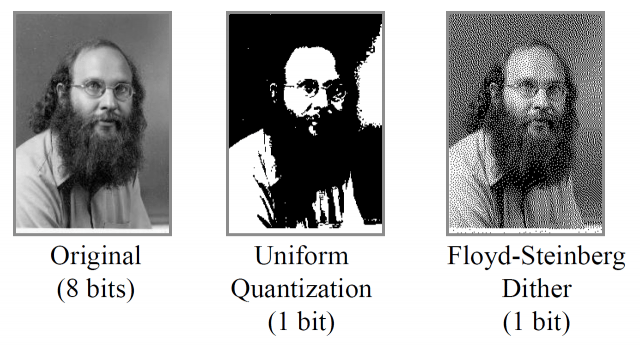As Serato’s DJ software programs gained FLAC support on Monday, we decided it’s time to write an article that discusses the best options of the variety of formats that digital audio files come in. Many DJs don’t notice a big difference in file type and bitrate until they’re blasting the track on a high-end club system and find the track just isn’t hitting hard enough. Read on to find out the best practices and how to be ready for the future.
LOSSLESS AND LOSSY AUDIO: WHAT’S THE DIFFERENCE?
While the image above makes it pretty clear as to what the results of different compression can do to an image, Here’s a quick refresher on the two groups of audio files out there:
Lossless audio files are files that are used as masters. They can be uncompressed or compressed, but their compression retains all of the original data of the recording or final master. Lossless formats include WAVs, FLACs, AIFF, and Apple Lossless. Their file size tend to be large, and it’s not uncommon to see an compressed WAV that’s 30-40MB for a song that’s about 3:30 long.
Lossy audio files are compressed versions of tracks that have parts of the data removed to reduce the size of the file. The more compressed, the more data is missing. The most common form of lossy audio is MP3, although other less-supported and/or older formats like AAC, WMA, OGG, and MP2 still haunt many a music library. With lossy audio, you’ll want to pay close attention to the bitrate (see below), and a typical size for a 3:30 long song is just over 8MB.
WHAT DJS SHOULD USE AND WHY IT MATTERS
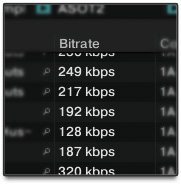 Here’s the key section for most of you. For many casual, non-DJing uses, a lower quality audio file is completely acceptable – when you’re listening to YouTube videos on laptop speakers, you’re not exactly pushing the requirements of audio fidelity. But when you’re playing at festivals or clubs with nice sound systems, you’ll want to make sure the files in your setlist will not limit the potential of the sound system.
Here’s the key section for most of you. For many casual, non-DJing uses, a lower quality audio file is completely acceptable – when you’re listening to YouTube videos on laptop speakers, you’re not exactly pushing the requirements of audio fidelity. But when you’re playing at festivals or clubs with nice sound systems, you’ll want to make sure the files in your setlist will not limit the potential of the sound system.
An overwhelming majority of performing DJs have a library of 320kps MP3 files – as even on large club PA systems the 320 MP3s will sound solid. (Funktion One systems – like in the image below – will eat 192kbps MP3s for breakfast).
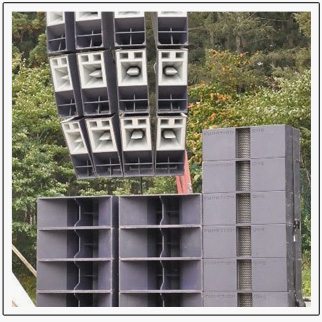 But when you’re making adjustments to the the audio, changing the tempo, pitch, and/or key, and processing it through your software and hardware and ultimately out to the mixer – you’ll really start to notice very quickly the level of quality you’re dealing with, and any artifacts will start to be noticeable, especially on a really nice system.
But when you’re making adjustments to the the audio, changing the tempo, pitch, and/or key, and processing it through your software and hardware and ultimately out to the mixer – you’ll really start to notice very quickly the level of quality you’re dealing with, and any artifacts will start to be noticeable, especially on a really nice system.
One of the biggest differences in quality happens when you start to change the tempo of the song. Whether in your DJ setup or DAW, you’ll notice that the higher the sample rate, the more information there is to “pull apart” when you slow it down, resulting in fewer artifacts and the closer to a master it will sound.
As a result, many DJs and audiophiles insist that there’s a lot of territory beyond sounding “solid” – and on the right system, there is a difference, it may not be the difference between good or bad, but it could be the difference between good and “freaking insane.” Two such artists committed to lossless audio include Sander Van Doorn and Loco Dice, as interviewed on Beatportal earlier this year:
DJ extraordinaire Sander van Doorn prefers “playing lossless files only,” he says. “As I want to guarantee my fans the best audio experience for every set.” And he’s definitely not the only one. Loco Dice echoes the sentiment, saying, “I play lossless files because the format contains uncompressed audio, gives me the maximum audio quality, and doesn’t fail when I combine digital files and vinyl records.”
As a digital DJ, your primary job is to deliver great sounds to the audience – so there’s little reason why you shouldn’t start out with the highest quality audio so that you preserve as much of the original quality as possible.
WHERE CAN A DIGITAL DJ GET LOSSLESS AUDIO TRACKS?
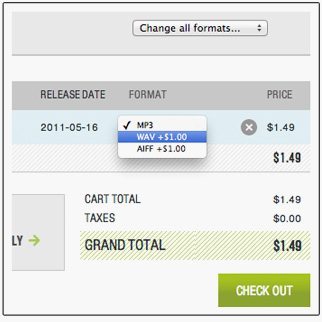 The reason that many digital DJs prefer 320 MP3s to a lossless format has more to do with file size and access/cost rather than audio quality.
The reason that many digital DJs prefer 320 MP3s to a lossless format has more to do with file size and access/cost rather than audio quality.
While we’re rapidly approaching an era in where storage and bandwidth aren’t limitations that will hold back lossless audio – but there’s still an associated fee and stigma found in a number of online music stores that makes it that much harder of a purchase.
The iTunes Music Store continues to be the behemoth in the legitimate online music world, but lacks any lossless download options, most likely due to potential server costs – but comparatively smaller services like Beatport, Boomkat, Juno Download, and others do offer lossless files at an increased rate. On Beatport, almost all tracks are available in AIFF and WAV formats, but you’ll need to pay up an extra dollar at checkout per track – which could easily make upgrading your entire library very unrealistic.
A note about tags: WAV files do not support ID3 tags – meaning that it’s harder to store information to be parsed apart in your DJ software like tempo, key, artist, album, etc. That’s why Beatport also offers files in AIFF format, which allows for full ID3 tagging!
File size should rapidly become less of a problem as disk space continues to get cheaper and cheaper, but it still takes about the same space to fit hundreds of 320s as 40 high quality WAV files. That reason alone saves big digital stores millions a year in hosting storage and data transfers!
BEWARE FAKE QUALITY TRANSCODES
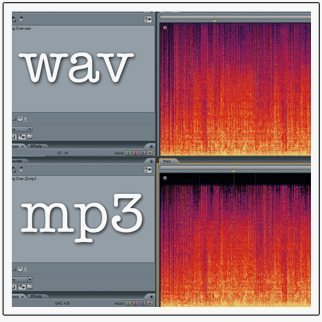 In the dark world of online music piracy*, there’s a higher value placed on files that are tagged as 320s or lossless audio – but just because a files is tagged as such doesn’t make it actually that quality. Bitrate is very easily to “fake” in file names or by transcoding (converting or re-recording) the audio file to a higher rate.
In the dark world of online music piracy*, there’s a higher value placed on files that are tagged as 320s or lossless audio – but just because a files is tagged as such doesn’t make it actually that quality. Bitrate is very easily to “fake” in file names or by transcoding (converting or re-recording) the audio file to a higher rate.
Oftentimes tracks ripped from YouTube or Soundcloud streams will be of 128 quality, but the actual recording tool is set higher – so you end up with a 320kbps or WAV file that still sounds pretty mediocre. The fakes will be easy to spot in a audio editing program – like in the example on the right, the compressed file is cut off, whereas the WAV waveform looks way more dynamic.
One of the simplest ways to instantly tell what type of file you’re getting from a friend or as a free download from an artist page is to look at the file size – if you’re expecting a 320 MP3 for a standard length track and the download is only showing a total size of 2 to 4 MB, it’s probably not legit.
*DJ TechTools in no way endorses music piracy – but we’re equally not fans of people playing really low quality audio files in clubs.
TEST YOUR EARS, FUTUREPROOF YOUR COLLECTION
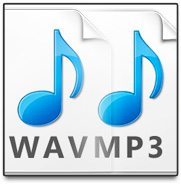 Want to see if you can tell the difference between a lossless WAV file and a 320 kbps MP3? In 2010, Noise Addicts made a great-but-simple online blind test for you to compare the playback of two files and hear the difference – so pull out your nicest set of headphones or speakers and see if you can tell the difference.
Want to see if you can tell the difference between a lossless WAV file and a 320 kbps MP3? In 2010, Noise Addicts made a great-but-simple online blind test for you to compare the playback of two files and hear the difference – so pull out your nicest set of headphones or speakers and see if you can tell the difference.
If you got rid of all of your CDs after ripping them to iTunes at 256kbps (or even worse… 192kbps) ten years ago and now you’re looking to upgrade your files to 320 or a lossless audio format, bad news. There’s no program out there that will magically turn your old rips into lossless audio – which is part of the appeal of having a completely lossless master file in the first place. For this reason its super important to make sure your iTunes’ “import settings” are optimized. Its a bit tucked away in the preferences, but you’ll want to create a custom setting because what iTunes calls, “high quality” is actually 128kbps (not high quality at all). Depending on your storage capabilities, we’d recommend using a lossless format, although if you do want to stick with mp3, you’ll want to make sure you have 320kbps selected and a 44.1 kHz sample rate.
If you’re ready to start building a lossless library, we recommend upgrading in a track-by-track, set-by-set fashion – building out your most played tracks and favorites is the best way to actually see if you can detect the difference. This will ensure that you have a great batch of easily-mixed songs if you suddenly find yourself offered a chance to DJ a set on your city’s nicest soundsystem.
BONUS: MAD ZACH’S PRODUCTION ADVICE
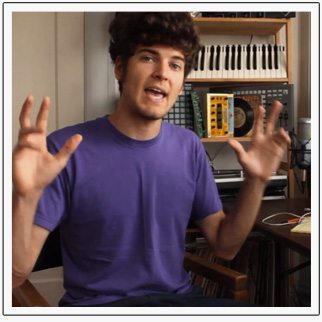 Many of our readers are budding producers – and we’ve already started to see original productions start rolling into the contest we launched last week. Audio quality matters immensely in the production process – so I asked Mad Zach to share his thoughts on what the most important production considerations are:
Many of our readers are budding producers – and we’ve already started to see original productions start rolling into the contest we launched last week. Audio quality matters immensely in the production process – so I asked Mad Zach to share his thoughts on what the most important production considerations are:
It’s important to set your DAW at the right audio quality, otherwise you might realize in the future that you’ve limited yourself by recording the best sample, synth, or vocal session of your life only in 16 bit! If at all possible set your system to 24bit and no lower than 44.1 kHZ. If your processor allows, put the sample rate up for super pristine sound. Most new machines can handle 48 kHz, which is what I usually run my computer at, although on days when I’m feeling extra smooth I’ll bump it up to 96 (which sounds crystal clear but definitely taxes my processor). The same principle applies to your VSTs and all of your various FX plug-ins. Whatever sample rate you are operating and recording your DAW at also determines the resolution of your VSTs. And don’t forget about dithering!
Dith-what?
Deep in the world of professional audio optimization is something called “dithering.” You’ll notice when you export a track from your DAW that you often get to choose whether or not to dither, and what type of dithering to use. Fatlimey, a longstanding member of the DJTT community, explains dithering the best below:
“Dithering is the process of shuffling around information to make the best use of the number of bits in each sample. Every sample in a stream of audio is represented using a fixed number of bits (e.g. 16-bit for CD, 24-bit for studio recordings, etc.) and a fixed rate at which those samples appear in time (e.g. 44.1 KHz, 16KHz, etc), so if you want to increase the quality of a signal the only thing left to play with is the placement of information in time. After quantization we take a little bit of the error here and move it over there, trade off a little bit of overshoot with reducing the adjacent sample a little. That’s essentially what “Error Diffusion” dithering does, it distributes the error throughout the signal making an overall better representation of the original signal using less bits. “Random Dithering” works by using specific forms of statistical random noise to do the same job of distributing the error.
In the diagram, the fine computer scientist’s neckbeard is quantized to the maximum extreme, just 1-bit per pixel and the results are pretty terrible. Apply some dithering to shuffle around the error and the resulting 1-bit per pixel image is a much better representation of the original. Do the same process with more than 2-, 4- or more bits per pixel and the results are practically indistinguishable from the original. That is until you start stretching it and the differences start to become apparent…” – Fatlimey
To Dither, or not to Dither, that is the question
If you’re scratching your head wondering “so… what do I do with all this information?” This means that you should use dithering any time you’re going from a higher quality to lower quality i.e. if you mixed your track in 24 bit 48 kHz but you want to export at 16 bit and 44.1 kHz (for burning cd’s). You’ll find the option to dither in your export menu. The various dithering styles refer to different algorithms that prioritize different elements of the mix. When it comes to the practical application of dithering your exports, Ableton provides a very helpful explanation:
“If you are rendering at a bit depth lower than 32-bit, choose one of the dither modes. Dithering adds a small amount of noise to rendered audio, but minimizes artifacts when reducing the bit depth. By default, Triangular is selected, which is the safest mode to use if there is any possibility of doing additional processing on your file. Rectangular mode introduces an even smaller amount of dither
noise, but at the expense of additional quantization error. The three Pow-r modes offer successively higher amounts of dithering, but with the noise pushed above the audible range. Note that dithering is a procedure that should only be applied once to any given audio. If you plan to do further processing on your rendered track, it’s best to render to 32-bit to avoid the need for dithering at this stage. In particular, the Pow-r modes should never be used for any material that will be sent on to a further mastering stage – these are for final output only.” – Ableton
The difference comes out in the headroom and harmonics. While an MP3 might cover all the bases, it’s still going to squeeze that frequency range into as small a package as possible. But just as you wouldn’t put a plant or a human in a tight little space, when the waveform is allowed to “breath” it can also retain the harmonics that give it that extra character.
LOSSLESS IS THE FUTURE
With faster internet, larger drives, and constantly improving audio hardware, there’s no doubt that 320kbps MP3s may very well start to feel archaic to DJs in just a matter of years. The human ear and our ability to perceive sound likely won’t improve (fictional cybernetic implants excluded), but making the move to lossless will ensure that your collection has a dynamic range that sounds and feels great in the mix well into the future of your DJ or production career.
How lossless is your DJ library? Let us know if you can hear the difference in your sets, or if you think that 320 MP3s will be the industry standard for some time to come.



